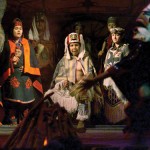Seattle Public Schools wants to preserve the five large murals of Native Americans painted on the Wilson-Pacific campus, which is scheduled for demolition. But the artist says he no longer wants to give the district his permission.
Posting of the modified page, February 24, 2013 at 10:24 PM
By Linda Shaw
Seattle Times education reporter
Two side-by-side portraits of Chief Seattle and Chief Joseph can be seen for blocks around North Seattle’s Wilson-Pacific school, an aging set of buildings now used for offices and programs, including one that historically has served Native American students.
Painted in black, white and gray, the murals each soar 25 feet high, with Chief Seattle, in his older years, sitting in a chair looking off to one side, and Chief Joseph, in his prime, staring straight ahead.
Andrew Morrison, an artist who grew up in the Seattle area, painted the murals and three others on the Wilson-Pacific campus over a period of about seven years, populating the school’s dull, beige walls with images of friends, acquaintances and a Haida mythical figure along with the two iconic chiefs.
The murals have become a touchstone for the surrounding Licton Springs neighborhood and the Native American community in Seattle, which has strong ties to the area because of the Native American programs at the school and nearby Licton Springs, once a tribal gathering place.
Now the murals’ fate is in limbo, as Seattle Public Schools, with the passage of a capital levy earlier this month, plans to tear down Wilson-Pacific and replace it with two new schools.
District officials hope to preserve all five murals by taking digital photographs of them, then reproducing them at the new school buildings. They have asked for Morrison’s permission and offered to pay the costs and give Morrison a seat on the school’s design committee, which would decide where the reproductions would be placed.
Morrison, 31, said he considered the officials’ offer and, last month, asked them to put their proposals in writing, which they did. But a week ago Sunday, standing in front of the two chiefs in a light rain, he said that after a lot of reflection, he’s decided he won’t give his permission for the district to reproduce his work.
He repeatedly congratulated the district for the passage of the levy, which he opposed. But Morrison said he’s lost trust in the district, in part because no school official approached him about saving the murals until he started showing up at public meetings about the levy. He also said he’s talked with four different officials, and has no confidence they won’t simply continue to pass him along.
“For many reasons,” he said, “it’s in my best interests to step away.”
A labor of love
Morrison, a member of the Apache and Haida tribes, created the first mural in 2001, a portrait of a Blackfeet friend from Canada.
Morrison didn’t attend the Indian Heritage Middle College, the district’s nearly 40-year-old program that has been at Wilson-Pacific since 1989. But he has volunteered at the school and has visited the campus for powwows, dinners, basketball tournaments and other events as long as he can remember.
Neighbors around Wilson-Pacific held a block party when that first mural was finished, and Morrison said that helped inspire him to keep going, even though he has received no pay for any of them.
He finished the second mural — images of friends and relatives wearing tribal regalia — on Sept. 11, 2001, just after the news that two airplanes had flown into the twin towers in New York City. He remembers Indian Heritage students and teachers coming out on the playground, surprised but happy to see something positive on that difficult day.
He finished the last two murals — Chief Joseph and the one with the Haida mythical figure — in 2007.
Morrison’s work also can be seen in Chicago, Portland, Alaska and Idaho as well as many places in Washington state, including the Snoqualmie Casino, El Centro de La Raza and Edmonds Community College.
“Cultural continuity”
During the levy campaign, a number of people urged the district to renovate Wilson-Pacific rather than replace it, and to revitalize the Indian Heritage program, which has dwindled in size and also has an uncertain future. The program’s supporters wanted the murals saved, too.
The murals “are an affirmation of our identity,” said Sarah Sense-Wilson, who chairs the Urban Native Education Alliance and helps coordinate the Clear Sky Native Youth Council, which also meets at the school. Destroying them, she said, “destroys the site’s cultural continuity.”
Bethany Elliott, a 17-year-old member of the council, said she often thinks of the murals as a source of inspiration when she writes poetry.
Still, both of them say they stand by Morrison’s decision to withhold his permission to save them.
Dr. Kelvin Frank, executive director of the United Indians of All Tribes Foundation, said he supports whatever Morrison decides, too, even though he also values the murals at Wilson-Pacific and the one Morrison created for United Indians at the Daybreak Star Cultural Center in Discovery Park.
“As American Indians, very seldom do we see this type of work being displayed in urban settings,” Frank said. “When we do, we take it to heart.”
Some of the neighbors who live around Wilson-Pacific helped Morrison get a grant to help pay for the materials for the Chief Joseph portrait.
Morrison is proud of how the murals have raised awareness of Native American history, and says they’ve been one key to his artistic success. He said he went to great lengths to try to find common ground with the district, but didn’t feel those efforts were returned.
District officials say they thought they were on good terms with Morrison, and hope he’ll change his mind.
“It is our desire to save his work,” said Lucy Morello, director of capital projects.
Still, she said, they don’t want to go forward, even if they could, without his cooperation.
Morrison hasn’t told the district that he doesn’t want the murals reproduced, Morello said. She hopes that’s a sign that there’s still a chance they can work together.
There’s time, she says, because the construction of the new schools won’t start for several years.
Linda Shaw: 206-464-2359 or lshaw@seattletimes.com. On Twitter: @LShawST
View Article and photos of Mural paintings here.
















